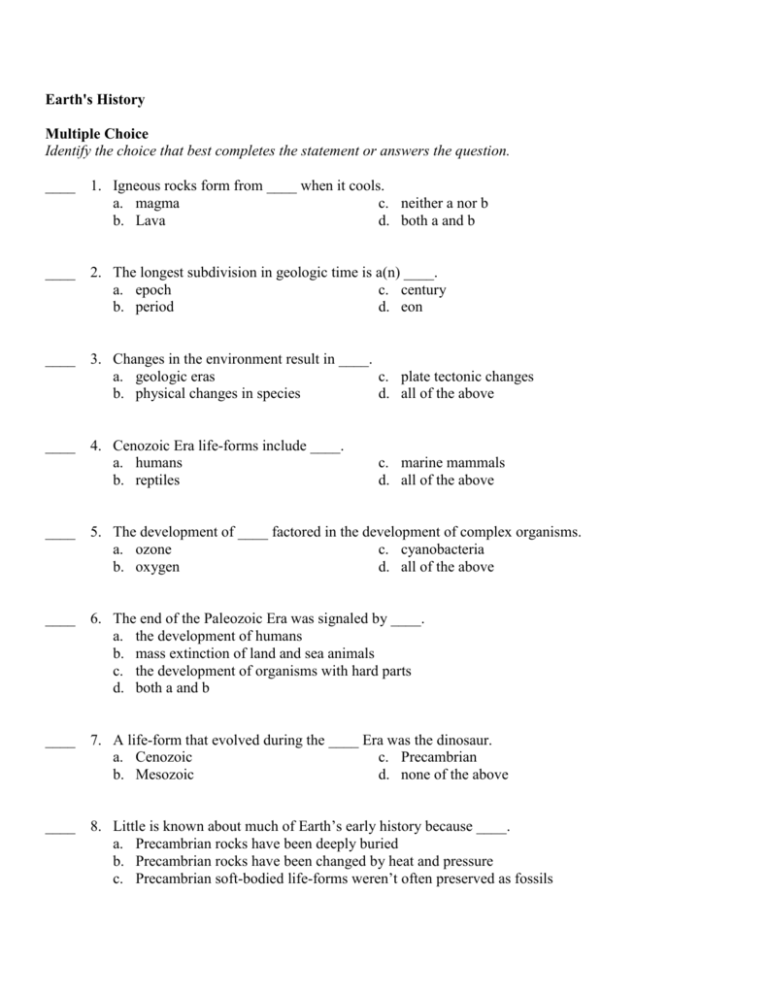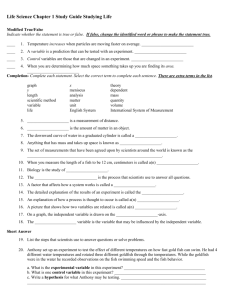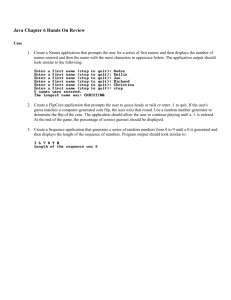Earth History Unit Test
advertisement

Earth's History Multiple Choice Identify the choice that best completes the statement or answers the question. ____ 1. Igneous rocks form from ____ when it cools. a. magma c. neither a nor b b. Lava d. both a and b ____ 2. The longest subdivision in geologic time is a(n) ____. a. epoch c. century b. period d. eon ____ 3. Changes in the environment result in ____. a. geologic eras c. plate tectonic changes b. physical changes in species d. all of the above ____ 4. Cenozoic Era life-forms include ____. a. humans b. reptiles c. marine mammals d. all of the above ____ 5. The development of ____ factored in the development of complex organisms. a. ozone c. cyanobacteria b. oxygen d. all of the above ____ 6. The end of the Paleozoic Era was signaled by ____. a. the development of humans b. mass extinction of land and sea animals c. the development of organisms with hard parts d. both a and b ____ 7. A life-form that evolved during the ____ Era was the dinosaur. a. Cenozoic c. Precambrian b. Mesozoic d. none of the above ____ 8. Little is known about much of Earth’s early history because ____. a. Precambrian rocks have been deeply buried b. Precambrian rocks have been changed by heat and pressure c. Precambrian soft-bodied life-forms weren’t often preserved as fossils d. all of the above ____ 9. If a species can adapt to a changing environment, or ____, its descendants will survive. a. evolve c. stay the same b. become extinct d. none of the above ____ 10. What time period did Tiktaalik appear on the Earth? a. Permian c. Homeobox gene b. Devonian d. Penny likes to fetch! Matching Match each item with the correct statement below. a. principle of superposition b. uniformitarianism ____ 11. states that for undisturbed rocks, the oldest rocks are on the bottom and the rocks become younger and younger toward the top ____ 12. states that Earth processes today are similar to those that took place in the past Match each rock type to accurately complete the sentence below: a. Igneous rock c. Metamorphic rock b. Sedimentary rock ____ 13. can melt to form magma. ____ 14. is useful in dating fossils. ____ 15. is formed from volcanic material. Match each geological times to the description below. A geological times may be used more than once. One or more geological times may match. a. Cenozoic e. Paleozoic b. Triassics f. Pennsylvanian c. Ordovician g. Mesozoic d. Archean h. Proterozoic ____ 16. stromatolites were common ____ 17. Cambrian explosion ____ 18. Ediacaran fauna ____ 19. first land plants ____ 20. dinosaurs evolved Completion Complete each statement. Figure 4 21. Refer to Figure 4. The graph shows radioactive decay of an isotope. It shows that after two half-lives (2T), the percent of original isotope remaining is ____________________. Figure 5 22. Refer to Figure 5. At time A, the mountain was 5,000 meters high. Today it is 1,000 meters high. If erosion has proceeded at a constant rate, it was about ____________________ meters high at time B. True/False Indicate whether the statement is true or false. ____ 23. One ancient species of bird had a dinosaur-like skeleton with feathers. ____ 24. Precambrian rocks are hard to study because they have been changed by metamorphism. ____ 25. Plate tectonic movements have caused the destruction of much evidence from Precambrian times. Modified True/False Indicate whether the statement is true or false. If false, change the identified word or phrase to make the statement true. Figure 7 ____ 26. Refer to Figure 7. Layer A is probably the oldest layer. _________________________ ____ 27. The first human fossils are found in rocks from the Mesozoic Era. _________________________ Short Answer 28. How do the absolute and relative ages of rocks differ? Which is more useful to scientists, and why are both used? Earth's History Answer Section MULTIPLE CHOICE 1. ANS: D PTS: 1 DIF: 1 STA: 7.4.c 2. ANS: D PTS: 1 DIF: 1 STA: 7.4.a 3. ANS: B PTS: 1 DIF: 1 STA: 7.3.a 4. ANS: D PTS: 1 DIF: 1 STA: 7.3.a 5. ANS: D PTS: 1 DIF: 1 STA: 7.3.a 6. ANS: B PTS: 1 DIF: 1 STA: 7.3.a 7. ANS: B PTS: 1 DIF: 1 STA: 7.3.a 8. ANS: D PTS: 1 DIF: 1 STA: 7.4.a 9. ANS: A PTS: 1 DIF: 1 STA: 7.3.e 10. ANS: A PTS: 1 MATCHING 11. ANS: A PTS: 1 DIF: 1 STA: 7.4.c 12. ANS: B PTS: 1 DIF: 1 STA: 7.4.a 13. ANS: C PTS: 1 NOT: What does magma become? DIF: 3 STA: 7.4.c 14. ANS: B PTS: 1 NOT: Where are fossils found? DIF: 3 STA: 7.4.c 15. ANS: A PTS: 1 NOT: What comes out of volcanoes? DIF: 3 STA: 7.4.c 16. ANS: D PTS: 1 NOT: What ate them? DIF: 3 STA: 7.4.b | 7.4.c | 7.4.g 17. ANS: E PTS: 1 NOT: When was the Pre-Cambrian? DIF: 3 STA: 7.4.b | 7.4.c | 7.4.g 18. ANS: H PTS: 1 DIF: 3 NOT: After what crisis did this happen? STA: 7.4.b | 7.4.c | 7.4.g 19. ANS: C PTS: 1 NOT: What did that make possible? DIF: 3 STA: 7.4.b | 7.4.c | 7.4.g 20. ANS: B PTS: 1 NOT: What happened then? DIF: 3 STA: 7.4.b | 7.4.c | 7.4.g STA: 7.4.d NOT: What does half-life COMPLETION 21. ANS: 25 PTS: 1 mean? DIF: 4 22. ANS: 3,000 PTS: 1 DIF: 4 STA: 7.4.a NOT: How much has the height changed altogether? TRUE/FALSE 23. ANS: T PTS: 1 NOT: What were Archaeopteryx? DIF: 2 STA: 7.4.e 24. ANS: T PTS: 1 DIF: 2 NOT: What happens to rocks at the deepest levels? STA: 7.4.c 25. ANS: T PTS: 1 DIF: 2 NOT: What happens at subduction zones? STA: 7.4.f MODIFIED TRUE/FALSE 26. ANS: F, D PTS: 1 formed? DIF: 3 STA: 7.4.c 27. ANS: F, Cenozoic PTS: 1 DIF: 2 STA: 7.4.e NOT: What was found in the Mesozoic Era? SHORT ANSWER NOT: How are rock layers 28. ANS: Possible answer: Absolute age is the real age, usually determined by radioactive dating.It is more accurate than relative age, which is based on comparison with older or younger rocks or fossils. However, in some cases only relative age can be determined. PTS: 1 measured? DIF: 5 STA: 7.4.d | 7.4.e NOT: How is each








